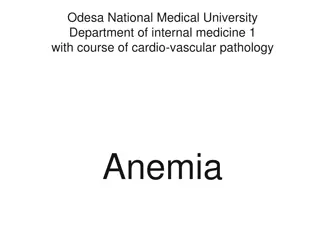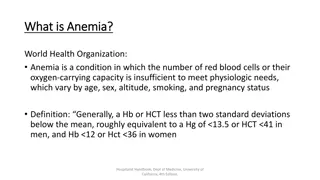
Iron Deficiency Anemia and Its Management
Iron deficiency anemia is a condition resulting from low iron levels, leading to reduced red blood cell production. Learn about its causes, symptoms, and effective management strategies including dietary changes, supplements, and addressing underlying conditions.
Download Presentation

Please find below an Image/Link to download the presentation.
The content on the website is provided AS IS for your information and personal use only. It may not be sold, licensed, or shared on other websites without obtaining consent from the author. If you encounter any issues during the download, it is possible that the publisher has removed the file from their server.
You are allowed to download the files provided on this website for personal or commercial use, subject to the condition that they are used lawfully. All files are the property of their respective owners.
The content on the website is provided AS IS for your information and personal use only. It may not be sold, licensed, or shared on other websites without obtaining consent from the author.
E N D
Presentation Transcript
ANEMIA SUJATA WALODE, TUTOR, MGM SBSA
DEFINITION Anemia: Anemia is a medical condition characterized by a decrease in the number of red blood cells (RBCs) or a reduction in the amount of hemoglobin in the blood. Hemoglobin is a protein within red blood cells that binds to oxygen and carries it from the lungs to the body's tissues. Anemia can lead to reduced oxygen-carrying capacity and result in symptoms such as fatigue, weakness, and paleness. Iron Deficiency Anemia (IDA): Iron deficiency anemia is a specific type of anemia caused by inadequate iron levels in the body. Iron is essential for the production of hemoglobin. When the body doesn't have enough iron, it can't produce enough hemoglobin, leading to fewer and smaller red blood cells.
PATHOPHYSIOLOGY The pathophysiology of iron deficiency anemia involves a decreased supply of iron to the bone marrow, where red blood cells are produced. This can occur due to several factors, including: Inadequate Dietary Intake: Not consuming enough iron-rich foods, such as meat, poultry, fish, beans, and leafy greens. Poor Iron Absorption: Conditions like celiac disease, Crohn's disease, and surgical removal of parts of the intestine can impair iron absorption. Blood Loss: Chronic bleeding from sources such as gastrointestinal ulcers, heavy menstrual periods, or frequent blood donation can deplete iron stores. Increased Demand: Pregnancy, rapid growth in children, and intense physical training can increase the body's demand for iron.
Causes Causes: The main causes of iron deficiency anemia include: Inadequate dietary intake of iron-rich foods Blood loss due to menstruation, injury, surgery, or underlying medical conditions Poor iron absorption due to gastrointestinal disorders or surgeries Symptoms: Fatigue and weakness Pale skin and conjunctiva (whites of the eyes) Shortness of breath Headache Dizziness or lightheadedness Cold hands and feet Brittle nails Tongue inflammation (glossitis)
MANAGEMENT The management and treatment of iron deficiency anemia involve addressing the underlying cause and replenishing iron stores. This can include: Dietary Changes: Increasing intake of iron-rich foods such as lean meats, poultry, fish, beans, lentils, tofu, fortified cereals, and leafy greens. Iron Supplements: In cases of severe deficiency, oral iron supplements may be prescribed. These should be taken as directed by a healthcare professional. Treating Underlying Conditions: Addressing any gastrointestinal disorders or chronic bleeding sources to prevent ongoing iron loss. Blood Transfusions: In severe cases with significantly low hemoglobin levels, a blood transfusion may be necessary to quickly increase the oxygen-carrying capacity of the blood. Lifestyle Modifications: Managing heavy menstrual bleeding, avoiding excessive blood donation, and addressing factors contributing to iron loss.
Anesthetic management of anemic patients requires careful consideration to ensure patient safety and optimal outcomes during surgery or medical procedures. Anemia can affect the body's ability to transport oxygen, which can have implications for anesthesia, surgery, and postoperative recovery. Here are some key considerations when managing anemic patients under anesthesia: Preoperative Evaluation: Assessment of Anemia Severity: Determine the severity of anemia through laboratory tests, including hemoglobin and hematocrit levels. The type and cause of anemia should also be identified if possible. Underlying Cause: Identify and address the underlying cause of anemia, such as nutritional deficiencies, chronic disease, or blood loss, prior to the procedure whenever possible. Cardiovascular Evaluation: Assess the patient's cardiovascular status, as anemia can lead to increased cardiac output and compensatory mechanisms. Evaluate for signs of heart failure or compromised cardiovascular function.
ANESTHESIA TECHNIQUES Oxygenation and Ventilation: Monitor oxygenation and ventilation closely during anesthesia to ensure adequate oxygen delivery. Adjust ventilation parameters as needed to maintain appropriate oxygen levels. Hemodynamic Monitoring: Continuous hemodynamic monitoring is essential to assess cardiac output, blood pressure, and other parameters. Anemic patients may have reduced blood volume, and careful fluid management is crucial. Choice of Anesthetic Agents: Select anesthetic agents that have minimal depressive effects on the cardiovascular system. Anemic patients may be more sensitive to the hemodynamic effects of anesthetics. Transfusion Thresholds: Determine transfusion thresholds based on the patient's clinical condition, hemoglobin levels, and physiological factors. Transfusion may be considered if the anemia is severe and associated with symptoms or inadequate oxygen delivery.
Intraoperative Care: Temperature Management: Maintain normothermia, as anemic patients may be more susceptible to temperature fluctuations, which can affect metabolic rate and oxygen consumption. Blood Loss Management: Minimize blood loss during surgery through meticulous surgical technique and the use of hemostatic agents. Autologous blood salvage systems may be considered. Postoperative Considerations: Monitoring: Continue close monitoring of vital signs, oxygenation, and hemodynamics in the postoperative period. Pain Management: Adequate pain management is important, as pain can increase metabolic demands and oxygen consumption. Choose analgesic strategies that minimize respiratory depression and cardiovascular effects. Fluid Management: Optimize fluid management to prevent volume overload or depletion, taking into account the patient's anemic status. Recovery: Anemic patients may require a longer recovery period to regain normal physiological parameters and prevent postoperative complications.






















